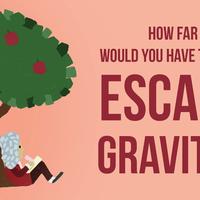How far would you have to go to escape gravity? - Rene Laufer
More than six thousand light years
from the surface of the earth,
a rapidly spinning neutron star
called the Black Widow pulsar
blasts its companion brown dwarf star with radiation
as the two orbit each other every 9 hours.
Standing on our own planet,
you might think you're just an observer of this violent ballet.
But in fact, both stars are pulling you towards them.
And you're pulling back,
connected across trillions of kilometers
by gravity.
Gravity is the attractive force between two objects with mass—
any two objects with mass.
Which means that every object in the universe attracts every other object:
every star, black hole,
human being, smartphone, and atom
are all constantly pulling on each other.
So why don't we feel pulled in billions of different directions?
Two reasons: mass and distance.
The original equation describing the gravitational force between two objects
was written by Isaac Newton in 1687.
Scientists' understanding of gravity has evolved since then,
but Newton's Law of Universal Gravitation
is still a good approximation in most situations.
It goes like this:
the gravitational force between two objects
is equal to the mass of one
times the mass of the other,
multiplied by a very small number
called the gravitational constant,
and divided by the distance between them, squared.
If you doubled the mass of one of the objects,
the force between them would double, too.
If the distance between them doubled,
the force would be one-fourth as strong.
The gravitational force between you and the Earth pulls you towards its center,
a force you experience as your weight.
Let's say this force is about 800 Newtons
when you're standing at sea level.
If you traveled to the Dead Sea,
the force would increase by a tiny fraction of a percent.
And if you climbed to the top of Mount Everest, the force would decrease—
but again, by a minuscule amount.
Traveling higher would make a bigger dent in gravity's influence,
but you won't escape it.
Gravity is generated by variations in the curvature of spacetime—
the three dimensions of space plus time—
which bend around any object that has mass.
Gravity from Earth reaches the International Space Station,
400 kilometers above the earth,
with almost its original intensity.
If the space station was stationary on top of a giant column,
you'd still experience ninety percent
of the gravitational force there that you do on the ground.
Astronauts just experience weightlessness
because the space station is constantly falling towards earth.
Fortunately, it's orbiting the planet fast enough that it never hits the ground.
By the time you made it to the surface of the moon,
around 400,000 kilometers away,
Earth's gravitational pull would be
less than 0.03 percent of what you feel on earth.
The only gravity you'd be aware of would be the moon's,
which is about one sixth as strong as the earth's.
Travel farther still
and Earth's gravitational pull on you will continue to decrease,
but never drop to zero.
Even safely tethered to the Earth,
we're subject to the faint tug of distant celestial bodies and nearby earthly ones.
The Sun exerts a force of about half a Newton on you.
If you're a few meters away from a smartphone, you'll experience
a mutual force of a few piconewtons.
That's about the same as the gravitational pull
between you and the Andromeda Galaxy,
which is 2.5 million light years away
but about a trillion times as massive as the sun.
But when it comes to escaping gravity,
there's a loophole.
If all the mass around us is pulling on us all the time,
how would Earth's gravity change
if you tunneled deep below the surface,
assuming you could do so without being cooked or crushed?
If you hollowed out the center of a perfectly spherical Earth—
which it isn't, but let's just say it were—
you'd experience an identical pull from all sides.
And you'd be suspended, weightless,
only encountering the tiny pulls from other celestial bodies.
So you could escape the Earth's gravity in such a thought experiment—
but only by heading straight into it.

